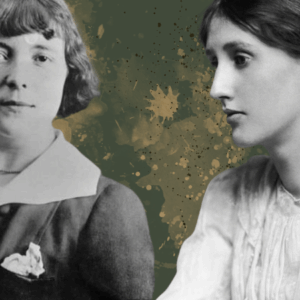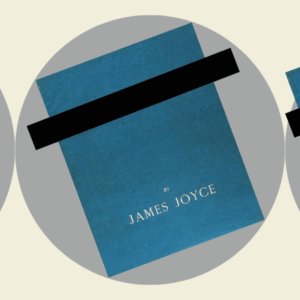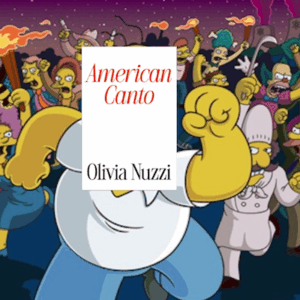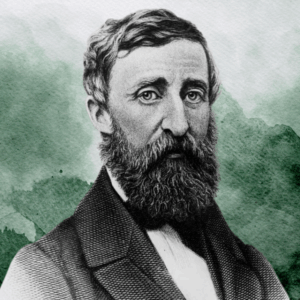
What Oslo’s Future Library Means for Writers and the Written Word
Martin Puchner on the Survival of Culture Throughout the Ages
In 2015, Margaret Atwood boarded one of the noiseless electric streetcars that zip around Oslo and let herself be pulled into the hills above the city. From the station, she took a well-preserved forestry road straight up into the woods, the path marked by white arrows. She was accompanied by a couple of dozen people, all decked out in hats and raincoats, or carrying umbrellas, due to a persistent drizzle. As this colorful flock made its way through the woods, the road gave way to a hiking path, reinforced with occasional planks to guide the hikers safely to their destination, a circular clearing in the woods.
Trees had been recently cut down, but new ones had been planted, the small saplings, six to eight inches tall, carefully protected from pests by a white coating. Between the saplings, Margaret Atwood and her companions were received with hot coffee, brewed in cast-iron pots over open fires, and chocolates. People stood around in groups or sat on the ground, taking pictures and talking, waiting for the ceremony to begin.
The first to speak was Katie Paterson, the creative mind behind the event. Hailing from Scotland, she had made a name for herself as an artist seeking to bring small- and large-scale processes, those too small or too large to be readily perceived by humans, into the perceptible realm. In her speech, she briefly rehearsed why they had assembled here, in the woods above Oslo. Then Atwood said a few words, before the main part of the ceremony could begin.
Atwood, whose dystopian novels depict the horrors of patriarchal control over women, the dangers of corporate oligarchs, and the potential consequences of genetic engineering, had brought a box tied with purple ribbons. The box contained a text called Scribbler Moon, Atwood explained; but that’s all she was allowed to say about it, according to the rules set up by Paterson, except perhaps to express the thinking behind the title, which she said was meant to bring together the idea of writing with that of time. Then Paterson approached and gave Atwood a quick peck on the cheek before taking the box and handing it over to a representative of the Oslo Public Library. “Be careful with the box,” she joked, or half-joked, or perhaps she was actually worried.
These gestures and acts didn’t have the rehearsed seriousness of a religious ceremony, nor were they mere theater; they were something in between. The representative then also delivered a brief speech, promising to take care of the box containing Scribbler Moon and to hand it over to its next guardian when the time came. After the ceremony, Atwood gave a brief interview, urging her audience not to kill the ocean. Then everyone slowly made their way home.
Since the rise of writing five thousand years ago, the written word has been endowed with prestige based in part on its supposed longevity.
Atwood was the first author Paterson had invited to contribute to an art project that combines an idea of long-term cultural storage with environmental sustainability. The clearing in the woods above Oslo is part of this project and is marked as such by a wooden sign screwed to a tree. In red letters it informs anyone who passes by that the clearing is part of Framtidsbiblioteket, a word translated into English as Future Library. Next to the three words are concentric circles that look like the rings of a tree.
Paterson’s idea was that for each of the following ninety-nine years, one writer would write a text, commit to keep everything about it, except its title, secret, and participate in the handing-over ceremony. The boxes containing the manuscripts are to be transported to a special room in the Oslo Public Library, where visitors can enter and look at the titles, but not read them or check them out. The texts will be kept under lock and key until the year 2114. At that point, they will be printed on paper made from the trees planted as saplings back in 2014. As the title of the project, Future Library, indicates, it is, like so much of Atwood’s fiction, about the future.
In a short text written for the occasion, Atwood mused:
Will any human beings be waiting there to receive it? Will there be a “Norway”? Will there be a “forest”? Will there be a “library”? How strange it is to think of my own voice—silent by then for a long time—suddenly being awakened, after 100 years. What is the first thing that voice will say as a not-yet-embodied hand draws it out of its container and opens it to the first page?
As Atwood added in an interview following the ceremony, writing for the future is what everyone has been doing, in the sense that writing is a technology that makes speech endure over time. What was different here was that Future Library created a deliberate interruption, a hiatus of ninety-nine years in the case of Atwood and diminishing each year, so that the final participant will see almost immediate publication, just as in a normal production cycle.
What does this experiment reveal? Through the handing-over ceremony, the solemn pledge of silence, and the guardianship of the library, Future Library calls attention to the institutions that allow cultural objects to be stored and conveyed into the future. “Will there be a ‘library’?” Atwood asked in her interview, putting cautious quotation marks around the word, perhaps worried that the very idea of the library might be undergoing change, or that it may cease to exist at all.
Norway, or the city of Oslo, could decide that libraries are a useless expenditure and sell off its holdings. The fate of the library, for Atwood, is bound up with a larger one: what will happen to Norway? If that state no longer exists, the library will be in the hands of some other governing entity or of no one at all.
Atwood’s question, “Will there be a ‘forest’?” shifts the discussion from states and institutions to the environment. Of the three parts of the project, the forest is the most unusual, the one that speaks to our gathering sense of environmental crisis and the need for sustainable practices. It is also the most vulnerable. Climate change might mean that the saplings planted in 2014 will be unable to survive, threatened by new pests, extreme storms, forest fires, or the adverse effects of some desperate geo-engineering project gone wrong.
But the forests of Norway are vast, and Norway is not high on the list of countries most threatened by climate change. In this sense, Paterson’s choice is an apt one. Perhaps she was also inspired by the fact that Norway has become particularly engaged in environmentalism, boasting the highest percentage of electric vehicles, among other achievements. (Things get slightly more complicated when one remembers that these achievements were paid for, at least indirectly, by Norway’s large oil reserves.)
Of course, future librarians might decide to jettison the part of the project stipulating that these works be printed on paper made from those trees and instead put them up on the internet, which might be environmentally preferable (provided that the electricity powering it is produced in a sustainable manner). Cloud storage might also offer the best chances for survival, though some have worried about the longevity of electronic storage, given how quickly formats change and become illegible.
The long history of culture presented in Culture: The Story of Us, from which this excerpt is taken, adds a cautionary note for all projects of long-term preservation. An overwhelming amount of written literature has been lost, and the rare fragments that have been dug up had become illegible by the time they were recovered, either because the language or the writing system had been forgotten or because the physical writing surface had decayed.
Like many societies today, Future Library places its trust in the written word. Since the rise of writing five thousand years ago, the written word has been endowed with prestige based in part on its supposed longevity, in contrast to the fleeting nature of the spoken word, which tends to be devalued as fleeting and ephemeral (there are exceptions to this rule: traditions of secret knowledge deemed too precious to be entrusted to writing).
In truth, oral traditions can be surprisingly resilient, offering distributed storage based on dedicated humans rather than on external storage devices and symbolic recording systems that can easily be destroyed. Oral traditions can also be more flexible than written ones, adapting to new environments, whereas writing is dependent on a particular recording system and code.
Thus far, most of the authors who have contributed to the project are from the global north—the Canadian Margaret Atwood and the English David Mitchell were followed by the Icelandic poet Sigurjón Birgir Sigurõsson and the Norwegian Karl Ove Knausgård. They were joined by authors who are predominantly based in the global north, such as Elif Shafak, a novelist from Turkey who has been partly living in London, and Ocean Vuong, a Vietnamese-born poet and novelist who mostly grew up in the United States and lives in western Massachusetts.
Han Kang, a poet and novelist from South Korea, lives outside the anglosphere, but she has found great acclaim in the English-speaking world since winning the London-based International Booker Prize for her novel The Vegetarian in 2016. Only the eighth and, so far, most recent contributor, the Zimbabwean novelist, playwright, and filmmaker Tsitsi Dangarembga is from and continues to be based in the global south. She came to international prominence through another international prize, the Commonwealth Writer’s Prize, which she received for her 1988 novel Nervous Conditions, written in English.
Collectively, these eight writers represent a version of world literature that slants not only northward but also anglophone (on the Future Library website, their titles are listed only in English, regardless of the language of the works themselves). In this, Future Library mirrors world literature and its system of publishing conglomerates and prizes, which tend to be based in northern Europe and North America. The Nobel Prize in Literature, after all, was created in Sweden and is presided over by the Swedish Academy and its members.
To be sure, the Nobel Prize committee has made efforts to honor writers from the global south, beginning with the 1913 award to Rabindranath Tagore, through the 1986 award to Wole Soyinka to the 2021 award to Abdulrazak Gurnah, the latter bestowed, in the words of the Academy, “for his uncompromising and compassionate penetration of the effects of colonialism and the fate of the refugee in the gulf between cultures and continents.” It will be interesting to see how Future Library—and publishing markets more generally—will evolve over the course of the next ninety-some years until 2114.
The future is unpredictable, reminding us that culture is, at best, a broken chain that we keep repairing in every generation.
The Future Library was interrupted in 2020, only six years after its launch, by the coronavirus. The smooth workings of the project, which by then boasted a brand-new room in a brand-new library building, the saplings growing nicely in the forest, the annual ritual of the handing-over ceremony attracting visitors, many sleek videos produced, edited, and posted on the project’s simple but elegant website, aided by a well-functioning publicity apparatus—all this came to a screeching halt.
The trouble began with Knausgård. Because he lived in the UK, he was not able to travel to Norway for the handing-over ceremony due to virus-related travel restrictions. Meanwhile, Vuong had accepted the invitation to contribute but was having trouble writing due to the disruptions brought on by the pandemic. And so, the project was, at least temporarily, on hold, much sooner than anyone had expected.
This sudden interruption of a project premised on longevity highlights the fragility of the infrastructure necessary for the preservation of culture. If one hundred years seems a rather short time frame when compared to the tens of thousands of years of cave paintings or the five thousand years of writing, the virus showed just how prone to failure cultural institutions are all the time. We can build a wonderful new library supported by one of the most stable democracies and underwritten by a sovereign wealth fund, but a tiny virus, itself the product of environmental change, can bring travel and much else—though not the internet—to a standstill.
The future is unpredictable, reminding us that culture is, at best, a broken chain that we keep repairing in every generation. In the end, what will allow Future Library to continue after an interruption that came so much earlier than anyone would have predicted is something other than the longevity of trees, libraries, or Norway. It is whether people—Katie Paterson, writers, the press, the public—will still care about a project such as Future Library.
Will they? Future humans, for whom nature as we now know it might have become unavailable, might well consider the felling of trees for paper-making a grave ethical failing, and judge us every bit as severely as we now judge the authors of the past for their deviations from our legal, social, and moral norms (among the participants, only Han Kang expressed sadness at the thought of felling trees). The future might denounce Future Library as the typical product of a generation that wrecked the planet, on the grounds that planting some trees does not make up for the heavy environmental footprint of the entire project, with its significant carbon costs in travel and construction.
What Future Library must hope, then, is that future readers will accept this difference in values, that they will be willing to engage with humans from the past whose behavior they will almost certainly see as falling woefully short. This is the greatest trust that Future Library requires: a trust that the future will judge us less harshly than it may have reason to do, or at least appreciate and preserve our cultural creations despite their inadequacy by future standards.
This trust rests on shaky grounds. Cultural history is a history of destruction caused by environmental disasters like landslides and volcanoes as well as by foreign invaders and colonists acting out of ignorance and malice. But culture was also destroyed by latecomers beholden to new values and beliefs. Chroniclers erased the name of the Egyptian Queen Nefertiti from the record because they were genuinely disturbed by the new religious cult, based on the sun god Aten, she and her husband Akhenaten had instituted in the fourteenth century BCE, just as Tang-era Confucians persecuted Buddhist monks in 845CE because they thought those monks were shirking their duty to the state.
Likewise, medieval Christians could not imagine putting pagan Greeks and Romans on an equal footing with Christian ones. There are significant differences in the nature and extent of violence wrought during these and other cultural encounters, but they have in common that they resulted in the deliberate ruination of cultural objects, in addition to the loss of countless human lives.
To be sure, we’ve learned some lessons from the history of destruction that runs through culture. New laws have clamped down on outright theft, and more museums are returning artifacts that were extracted under colonialism, acquired under dubious circumstances or outright stolen. We are more sophisticated in preserving culture through UNESCO heritage sites and grass-roots initiatives, while also being more attentive to immaterial cultural practices such as dance and performance traditions as well as other forms of knowledge that are transmitted orally from teacher to student, from body to body. These are significant accomplishments in the handling of culture and need to be tirelessly promoted and implemented more broadly.
But the larger lessons of cultural survival are harder to learn, because the past keeps challenging our most cherished opinions and values. Every single text or object mentioned in Culture: The Story of Us survived by beating the overwhelming odds of destruction not only from natural disaster but also from deliberate sabotage. The Buddhist texts and statues that survived in China did so even though they disagreed with dominant Confucian and Taoist mores, just as Greek texts survived in Baghdad, during the golden age of Arabic letters, even though they were not written by followers of the Prophet Muhammad.
Likewise, some Christian Europeans were ready to reacquaint themselves with classical antiquity even though those authors were pagan, just as Aztecs, long before the arrival of the Spanish, incorporated objects of previous cultures into their own rituals despite their difference.
In all of these cases, cultural objects and practices survived even though they could be understood as threats to those who nevertheless assured their survival. These objects certainly challenged any sense of cultural purity. Again and again, cultural history shows that it is purists and puritans, those invested in ideas of spotless virtue of whatever stripe, that are most likely to engage in acts of cultural destruction.
Purists also deprive their own cultures of valuable resources by limiting access to meaning-making strategies from the past and from other societies. Cultures thrive on the ready availability of different forms of expression and meaning-making, on possibilities and experiments, and to the extent that cultural contact increases those options, it stimulates cultural production and development. Those invested in purity, by contrast, tend to shut down alternatives, limit possibilities, and police experiments in cultural fusion. By doing so, they impoverish themselves while condoning or encouraging the neglect and destruction of those aspects of the past that do not conform to their own, narrow standards.
Against such purists stand the heroes of this book, the people who dedicated their lives to the transmission and continuation of cultural traditions, including those who committed to memory long stories such as those of the Trojan War, and those who perfected cultural techniques such as mosaics, fresco paintings, and writing systems such as Egyptian hieroglyphics and Aztec picture-writing. Equally heroic are those who built institutions dedicated to preservation and transmission, including the great libraries of the ancient world, museums inspired by the new science of the past promoted by such nineteenth-century intellectuals as George Eliot.
Also included are those who facilitated (peaceful) cultural encounters, such as the Chinese traveler Xuanzang (602-664), who went to India to study Indian Buddhism, Ennin (794–864), the Japanese traveler who went to China to study Chinese Buddhism, and Japanese writers such as Sei Shōnagon (c. 966–c.1025) and Murasaki Shikibu (c.978–c.1014) who grappled with the legacy of Chinese culture in Japan. Despite the incomplete and often mistaken views about the countries these travelers visited (or heard about), they sought out encounters with other cultures in order to challenge their own assumptions and beliefs.
I like to imagine that readers of Culture: The Story of Us might do the same. None of the ancient works or their creators discussed in this book are without blemish. The cultures that shaped them had values and practices different from our own; they were products of societies few of us would like to live in. Like the societies that produced them, these works carry the values and injustices of their eras. Considering them worth preserving and accepting them as part of our common cultural heritage, does not require that we agree with the values of their era or single them out as moral examples to be emulated in the here and now.
None of the works I mentioned would hold up to this standard, from Nefertiti’s exploitative Egypt, its monuments a famous example of the enslavement of the workers who erected them, to the nineteenth-century historicists and archeologists intent on preserving the past often destroyed it inadvertently and were guilty of theft on a grand scale. All creators of culture must grapple with the violence and exploitation that is also part of cultural history, accept differences in values, and trust that the future will show them similar forbearance.
The culture of the past is the ground in which new cultures grow.
Today’s qualms about cultural borrowing and ownership are driven not only by the history of violence that runs through human culture but also by anxieties about how social media makes the circulation of culture seem frictionless. Has cultural “sharing” gone too far? I don’t think so, in part because it’s impossible to draw the line between “good” and “bad” sharing; ultimately, we must choose between isolation or circulation, purity or mixture, possessing culture or sharing it. Popular art serves many functions; one of them is as an index of the ways in which culture circulates at a given time. While we don’t need to hail every form of cultural mobility, every act of revival, and every internet phenomenon as an act of great significance, cultural history bends toward circulation and mixture.
If we want to support and sustain cultural invention, we need every means at our disposal. Unlike biological evolution, which is built into human life, culture can never be taken for granted. It depends on the people who take it upon themselves to preserve and revive culture in every generation, including archeologists, museum curators, librarians, artists, and teachers, and specifically it depends on their ability to inspire future generations.
The work of these teachers and intermediaries is more important than ever today, a time when universities, one of the institutions charged with preserving culture, tend to focus on technology and other STEM subjects. But it is not enough to blame others for the decline in the humanities as it is occurring in the United States and some other countries. The problem is in part home-made.
We humanists have not always lived up to our role in the promotion of a diverse cultural history, just as we have lost the public at large—the readers, parents, and students who should be our primary audience (at my university, 8 percent of the incoming class of 2021 declared a primary interest in the arts and humanities). I believe that only if we win back the broader public, only if we manage to communicate the significance and excitement of cultural diversity to the next generation, only if we keep alive the cultural treasures that our forebears wrought, will the arts and humanities thrive.
There is much the arts and humanities have to contribute. Our era is enamored with technological innovation and the promise that breakthrough solutions to our most pressing problems are just around the corner. But we can’t engineer our way out of today’s most intractable conflicts, which are based on age-old troubles involving clashing identities, colliding interests, and opposing beliefs. These conflicts can only be addressed if they are understood as reaching deep into the cultural past, which can only be achieved with the use of tools provided by the humanities.
The culture of the past is the ground in which new cultures grow—not for nothing is the word “culture” borrowed from agriculture. Culture needs to be tended by connecting humans living today with our distant ancestors, and with one another, so that the work of meaning-making can continue. We need all the cultural resources we can find to face our uncertain future, which will include massive disruptions from wars, migration, and climate change, as registered by Future Library.
Among the participants in Future Library, several were prompted by the project to contemplate the long history of culture. Atwood went all the way back to its distant origins:
picture this encounter—between my text and the so-far nonexistent reader—as being a little like the red-painted handprint I once saw on the wall of a Mexican cave that had been sealed for over three centuries. Who now can decipher its exact meaning? But its general meaning was universal: any human being could read it. It said: “Greetings. I was here.”
__________________________________

Excerpted and adapted from Culture: The Story of Us, from Cave Art to K-Pop by Martin Puchner. Copyright © 2023. Available from W.W. Norton & Company.
Martin Puchner
Martin Puchner is the Byron and Anita Wien Professor of English and Comparative Literature at Harvard University. He is a prize-winning and bestselling author whose books include The Language of Thieves: My Family’s Obsession with a Secret Code the Nazis Tried to Eliminate and The Written World: The Power of Stories to Shape People, History, Civilization. He is the general editor of The Norton Anthology of World Literature. He lives in Cambridge, Massachusetts. Twitter @martin_puchner












